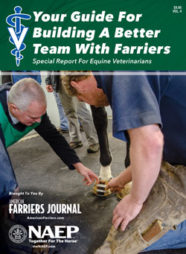Pictured Above: There is something liberating about working with your hands and the satisfaction from using your skills to solve problems that make the horses’ lives more pleasant. Photo: Butler Professional Farrier School
Farrier Takeaways
- A career in farriery is an opportunity for self-disciplined people who don’t mind hard work to be self-employed.
- An experienced full-time farrier can make more than $100,000, making it a good return on your educational investment.
- Making a difference in the lives of horses and their owners while working outdoors with your hands is more appealing for farriers than a desk job./li>
As you begin your farriery career, you will find it to be a soul-satisfying and lucrative trade. However, not everyone has what it takes to be a successful farrier.
Farriery is an ancient craft that has changed little over the centuries. The work is both an art and a science, requiring intellectual and physical skills. It is a professional service that keeps majestic horses sound. Although experience with horses before farrier training is most desirable, it’s not essential. What is essential, though, is common sense, a healthy body and a strong work ethic.
Excellent candidates are people with an entrepreneurial spirit that have the coordination to work accurately with hand tools. They enjoy physical work and continual learning. Patience is necessary since it takes several years of practice to excel at this difficult-to-master craft. Here are seven advantages of being a farrier.
You have the freedom to choose how you will spend your time …
- Be your own boss. Farriers are self-employed, independent business people who make a good wage doing a job they love. They are passionate about their work. They are not afraid of hard work and don’t mind sweating and getting dirty. They like people as well as horses. They are self-disciplined enough that they don’t need a boss to tell them what to do. In a down economy, even professionals may not have a job tomorrow. When you are self-employed and work for many clients, you have the freedom to choose how you will spend your productive time, as well as your free time.
- Make a good return on your educational investment. There is almost no other opportunity where you can invest so little time and money in training and tools and begin to make as much per working hour. Farrier income figures from the 2018 American Farriers Journal Farrier Business Practices Survey show that the average gross income (before expense deductions) for full-time American farriers with an average of 24 years of experience is about $102,000. The average cost of shoeing a horse is $153. A trim is about one-third as much. Farriers who are near population centers make much more than those who live in rural areas. Part-time farriers make about one-quarter of what full-time farriers make.
-
Work next to nature with magnificent animals. Working with sharp tools, fire, and animals that can kick and bite does come with its perils, but generally farriers find the benefits outweigh these challenges. Farriers get satisfaction from being able to use their skills and tools to solve problems and make the lives of the horses they work on and their owners, more pleasant. They make a very good wage for the hours they spend working.
However, there is risk involved in today’s litigious society. Professional farriers protect themselves with liability insurance and use corporate business organization. - Work with your hands. Farriers enjoy working with their hands and sharp tools. There is something liberating about working with your hands to create a thing of beauty from a deformed hoof and a bar of steel. The trained artist within is given free expression. Farriers work with simple tools to create fine craftsmanship. They are capable of making regular small changes that over time can make a huge difference in the lives of horses and their owners. Desk jobs do not appeal to most farriers.
- The satisfaction of completing work. Farriers know that completing a hard job is very satisfying, especially when knowing that they will be able to do it again and improve on it in an interval of 2 months or less. The typical horse is trimmed or shod at least seven times a year. Over half of farrier school graduates work as apprentices for a year or more before going on their own. They have found this to be the safest way to prevent getting in over their heads on cases that require a higher level of expertise. This way they have a mentor to obtain guidance from after they go out on their own.
- More family time possible. Since farriers are self-employed, they can schedule more family and free time, if desired. They can involve their family in the business in various ways. Farriers have passed their trade on to family members for generations. It can be very satisfying to have a family member follow in your footsteps. Eventually, busy farriers will want to schedule family time, as well as time with their clients. Families spell love, “T-I-M-E.”
- Low initial investment. Most professional businesses require formal education and a long training period before starting. The farrier business can be started almost immediately after attending a trade school with a very low investment of less than $15,000 in tools and training. Certification is desirable but not required in the U.S. Sterling character traits are of more concern to most horse owners.
The best farriers continually learn each time they work on a horse. Horses are great teachers. It usually takes several years to build a lucrative business, although there have been students who recouped their investment in less than a year and in a short time made more than they ever did in their previous employment.
Of course, talent varies among farrier students. For most, school is just the beginning. Everyone has different abilities and learns at a different rate.
Farrier work is best taught one-on-one. For the best chance of success, prospective farrier students need to get extensive horse experience, attend a recommended trade school and then work with an established mentor after school.
Much can be learned online and from books before and after school. Well-prepared students will have the greatest chance of success at school and in their future careers. Farrier work requires continual study and is rightfully called “The Master Craft.”










